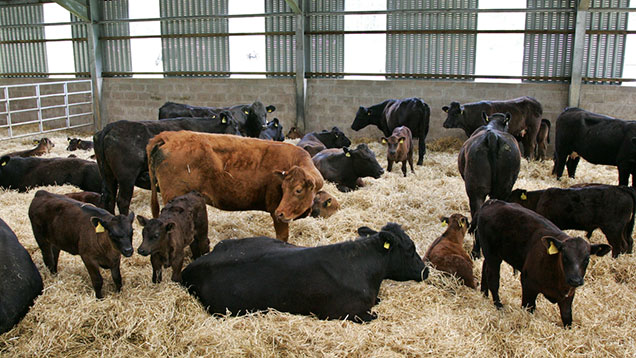Farmers’ key pneumonia questions answered

Winter is when cattle are at highest risk of respiratory diseases and a pneumonia-free past is no guarantee the disease will not strike this winter.
More than a third the farmers who took part in a Farmers Weekly survey who suffered an outbreak last year said it had come out of the blue after being disease-free for at least three years.
So what should farmers consider to ensure they don’t see the disease in their cattle this winter? Tim Potter of Westpoint Vets and Mark Stott of Farm Gate Vets, answer some key pneumonia questions.
How can I prevent condensation in my shed?
Pneumonia pathogens are spread through the air, but the drier and fresher the air the less likely they are to spread. If the air is humid, it increases the risk of pneumonia.
The key to reducing humidity and preventing condensation is all down to good drainage, says Mr Stott.
“You don’t want any freestanding water, particularly in your pens,” he says. “They have to pass the squelch test – if you walk around in them and you hear water squelching under your feet, you know you need to do something.”
Be aware that calves fed on automatic feeding machines urinate more, so you will need better drainage in the calf pens, he adds.
More on pneumonia
For a more detailed look at tackling pneumonia this winter, see our series of five articles, in association with Zoetis.
“Also bear in mind passageways. People may think they are being clean by regularly hosing down the passage, but it spreads water around which evaporates.
“It important to ensure drains aren’t blocked and if you need to reconcrete then ensure there is a sufficient slope to drain moisture away.”
What’s the simplest way to improve ventilation?
It depends on the building, and it’s very difficult to say there’s a simple answer, says Mr Stott.
“It’s not always the simplest, but the biggest failing is the lack of an outlet.
“Baby calves are a problem because they don’t produce enough body heat to draw air through a central ridge.
“Putting fans in could be one way to help things, but without the correct outlet it’s just stirring air, which doesn’t do any good.”
What are the most common symptoms of pneumonia?
Detecting the disease early is vital if you are to treat it successfully, so keeping an eye on cattle is important, says Mr Potter.
“The first sign of disease is usually loss of appetite, so farmers should take the temperature of any animal which is off its food,” he says.
“Some animals may develop a nasal discharge or a cough and are likely to suffer from laboured breathing.”
Can I keep cattle of different ages together?
If you can, avoid mixing ages of cattle, says Mr Stott. If it’s unavoidable, find a way to split the air by putting up panels so that each group has their individual air space.
“Quite often with pneumonia it isn’t a case of the pathogen being there or not: it’s the amount of pathogen that’s around and the cows’ ability to fight it off.
“Calves can catch low levels of the virus but might not be showing clinical signs. You can get older cows coughing the pathogens on to the younger ones.
“All-in, all-out is best, but in practice there will usually be a slow trickle of animals entering a shed.”
When should I vaccinate?
Planning ahead is also important in terms of vaccination, says Mr Stott. “If you have a batch of suckler calves, it would be nice to do it before you turn them inside. Often it’s done as they are being housed, but that can be too late: if you get the course completed before the stress period that can help.”
Some people rely heavily on vaccination, but if the other conditions all tip the balance in the favour of the pathogen then they may not do that much, he adds.
“You should be thinking about and talking to your vet about it now, as it should be part of your herd health plan.”
What should I do if I get pneumonia in my herd?
Once you have pneumonia its can be difficult to act on it without a loss in production, mostly due to issues with growth, but also in loss of calves, says Mr Potter.
Some people still wait until they have got it and then treat it, that can be a costly decision as animals will have a check in growth which will cost money in the long-term.
If you get the disease, it might not be too late though, he says.
“It gives you an opportunity to look at the building and ventilation and vaccinate the next batch of calves. It’s never too late to try to rectify a problem, but the earlier you do it the better results you get.”
